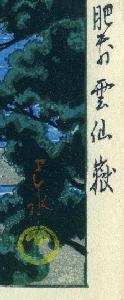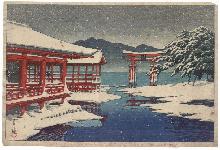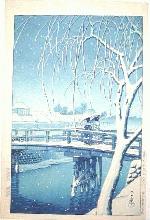These pages contain odd bits of Shin Hanga information that haven't yet found their contextual home in the Articles section or elsewhere. (Send yours in!)
|
Flotsam 1 12/20/99 "Recently some Koitsu prints (from the series 5 Lakes at Fuji) came up at dealers here in Tokyo in new condition with the Doi watermark and old style Harada/Yokoi seals (full Katakana writing). It has also the Doi Hangaten seal. It means, the seals fit perfectly with the print date Showa 9, April. "I feel, these prints are not printed in the 30ties, but later, maybe right now. These prints are offered at Tokyo galleries only recently. They sell for around 120USD, which is much less than you usually pay for a real old Koitsu. "I tried repeatedly to get an appointment with Mrs. Doi, but [ she has been unavailable ]. However, I do not want to come to any premature conclusions now." The above communiqué was floated in on coded bits of hosho, from our undercover correspondent at the front. More later.
| |||
|
Jetsam 2 December 1999. A rumor -- oh goody: "A friend who travels to Japan to buy prints tells me a rumor that Mrs Doi is in the market to sell all the blocks & late editions (a large quantity, I infer)."
| |||
|
Unattributed Jetsam 3 Undated "Worse... is to discover that, for example, not all woodblocks were really lost in the '23 earthquake, and there are restrike issues where one might not expect them. A lovely Koson of a crow on a branch, which is on the cover of Brown's catalogue "Shin-Hanga", was auctioned here recently, and is from re-cut blocks done after he left the publisher for Watanabe. I wouldn't have caught it had I not examined the auction photo compared with the books cover, then written to the seller to ask."
| |||
|
Q & A Varia 4 June 1999 Q: I have a Hiroshige print that appears to have a Watanabe stamp in the lower right corner. I'm wondering if Watanabe did a whole series of Hiroshige prints or just selected ones? Any help would be greatly appreciated. A: The 1936 Watanabe catalog lists many Hiroshige reproductions for sale, in a wide range of sizes. Also available were: (a) about 40 titles, all vertical prints, from the series "One Hundred Views of Edo", (b) "Eight Views of Eastern Capital (Edo)" in chuban size, and (c) a full set (half-size) of "Sixty-nine Stages of Kisokaido Highway" by Eisen and Hiroshige. The full set of "53 Stages of Tokaido Highway" was also available. About these, Watanabe said: "Those issued by my shop are of a half-size so as to be suitable for a portable souvenir, yet they retain a feeling of the first impression of the original pictures." This Tokaido set was itself a replacement for a full set of reproductions which Watanabe sold before the 1923 Great Earthquake and Fire. There would likely have also been Hiroshige images among three other destroyed sets: "A Collection of Pictures by the Great Ukiyoe Artists" (39 full-size prints), "A Collection of Ukiyo-e Masterpieces" (81 prints), and "A General View of Ukiyoe Pictures" (70+ prints). In addition, Watanabe offered many Hiroshige designs in a variety of small sizes: Small Card Size (about 72 x 51 mm), Medium Card Size (about 97 x 60 mm), Narrow Card Size (about 153 x 66 mm) and Post Card Size (about 156 x 85 mm). These supplemented the four larger sizes of Hiroshige reproductions, up to the regular oban size. "When writing a letter to a friend or to a relative, you might enclose a colour-print measuring up to Post-Card size, because its natural beauty would constitute the foundation of increasing intimacy between yourselves." -- S. Watanabe
| |||
|
More Q & A Flotsam 5 July 1998 (updated) Q: I recently looked at a Koson print which had been stamped "Made in Japan" on the back of the print. Does anyone know whether this dates the print to the post-World War II period and if Watanabe stamped his later prints in this way? Or is this stamp an indication that the print is probably a more recent copy made for export by some other publisher? A: Soon after World War I the U.S. began to require country-of-origin markings on imported goods, culminating in 1930 with the famous Smoot-Hawley Tariff Act. Hence the beginnings of "Made in Japan", including our then lowly woodblock prints. Prints not designated for export did not require this marking. We have seen many known valid early editions marked "Made in Japan" with either an ink stamp or a pasted-on paper tag (which can come off, perhaps explaining the high proportion of extant prewar prints lacking any apparent marking). More interesting to some is the period late 1945 to almost 1954, when the U.S. required "Made in Occupied Japan" markings.
So....if you see a print marked "Made in Japan", you're probably no better or worse off than if it was not there at all. You simply know that the print was designated for export to the U.S.
| |||
|
Minor Flotsam 6 January 2000 As to the question, often heard, as to whether Hasui ever PERSONALLY pencil-signed any of his own prints.... "Occasionally one finds prints signed in pencil in Western script. These signatures are not those of the artists but were added by Watanabe sales employees." -- Pachter, p. 37.
| |||
|
Odd Jetsam 7 January 2000 In an auction listing, John Mason provides this description of a Hasui doll print: Doro Ningyo from the series Gosho Ningyo by Kawase Hasui. Hasui created a set of 24 doll prints for Childrens Day in 1935. This particular doll is number seven of that set. The print measures 9.3 x 8.3 inches. Very good condition and tipped to the original paper backing with the number 7 on it. Black Hasui signature with red Hasui seal. Printed by Junji Kato.
| |||
|
Conversational Detritus 8 January 2000 Member A writes:
The Hasui book title translation index which I have does not specify a year of publication for this print, only that it was done by Bijutsusha, and the book representation of it is in black and white. Can anyone enlighten me on its history? The marginal printing shown on the jpg is the only carved writing on the print. Please examine this and tell me what you think. Helpful Member B replies: There was no hard fast and rule that seals had to be in red only and signatures in black only. Looking at the background of the area where the signature and seal are located on this print it can be noted that the area is almost black and certainly dark. A contrast to such dark area so that seal, etc. would show up would be something light such as light yellow or white. Since other prints by Hasui had black and red (2 colors so to speak) it was probably the choice of Bijutsusha to have light yellow for the seal and in this case red for the signature. Looks quite nice don't you think? As for the lack of date: Only two of the 6 Bijutsusha Hasui prints were dated and the dates were 1927 (the first one) and 1931 (the last one). According to my collected wisdom (my database) Bijutsusha produced prints for Kawase Hasui and Yamakawa Shühö only. My database is not infallible but the dates given include the period from 1927 to 1931. Convenient? No. Simply, that is all I have found to report. It would be safe to assume then that the print here was done around 1930. It was numbered as the 5th. design by Muneshige and the last design the 6th. was done in 1931. The last point, the kanji in the margin of the print reads "Hizen no Unzen (or sen) ga" which translates roughly to "craggy mountain Unzen in Hizen (province)." Hope all this helps... Grateful Member A again: Thanks for your information on my Hasui print. Your logic seems reasonable about not placing a dark seal over a dark area of the print, however on many other prints they simply placed it over a lighter area, the exact location seeming to be dictated by an aesthetic balance with the composition. Do you have any information about the placement of seals within a composition, and whether it is based on any other considerations than that? The seal issue in prints seems very traditional, or consistent, and I wondered therefore whether this may have been a special edition, a proof, a sales sample, or some such thing that would therefore call for a different representation of the seal. In your knowledge, did Bijutsusha change the color of the seal in any other of Hasui's prints they did? Now Member C jumps in: Another tidbit in response to your question. There was a small folio published of the New Eight Views, which is mentioned on ShinHanga.net -- available to members here. The 8 prints are tiny (real) woodblocks, carefully and accurately reproducing all 8 Bijutsusha oban prints. Only one of these small ones, your print B6 "Mt. Unzen in Hizen Province", has the red and yellow. All the others had the regular black and red. To me this sort of indicates that the "standard" (and probably only) state of this oban print had the red and yellow. Perhaps an experiment, and no more. Maybe this is what drove Hasui to drink.... Member A once more: Thanks for the additional tidbit. Is it the case then that I have the only known print by Hasui to sport the yellow seal? Interesting. Has anyone done a comparative study of printing quality between the different publishing houses? Member X: Hey, no more questions for you.
| |||
|
Miscellanous Nugget 9 January 2000 In an auction listing, Thomas Crossland provides this description of a Hasui print: Our trusty shortwave wireless was able to pick up the original transmission that so fortified our Mr. Crossland. Bouncing in off the inversion layer, here it is:
| |||
|
One-Upmanship 10 (pursuant to #8 above) February 2000 Member D jumps in a little later:
|
|
|
|



